Paltothyreus tarsatus (Fabricius)
  Type location Senegal (Formica
tarsata, Fabricius, 1798: 280, worker; Latreille,
1802c: 736, queen; Paltothyreus
tarsatus Fabr., Mayr, 1866b: 893, male; in Pachycondyla, Bolton 1995: 310; Paltothyreus revived by Schmidt
& Shattuck, 2014: 124) from Gorée Is, Dom. Bosc
collection - no images of type on Antweb (November 2018). Type location Senegal (Formica
tarsata, Fabricius, 1798: 280, worker; Latreille,
1802c: 736, queen; Paltothyreus
tarsatus Fabr., Mayr, 1866b: 893, male; in Pachycondyla, Bolton 1995: 310; Paltothyreus revived by Schmidt
& Shattuck, 2014: 124) from Gorée Is, Dom. Bosc
collection - no images of type on Antweb (November 2018).
subspecies
delagoensis (Paltothyreus
tarsatus Fr. var. delagoensis
n. var., Emery, 1899e: 468, worker & queen)
from Mozambique, Delagoa Bay - http://www.antweb.org/specimenImages.do?code=casent0903862
mediana (Paltothyreus
tarsatus F. var. mediana
n. var., Santschi, 1919h: 80, all forms) from Congo,
Brazzaville,
collected by A. Weiss - see http://www.antweb.org/specimenImages.do?code=casent0915277
robusta (Paltothyreus
tarsatus F. var. robusta
n. var., Santschi, 1919h: 81, worker & queen)
from Somalia, Buarsangueli, Revoil - see http://www.antweb.org/specimenImages.do?code=casent0915278
striata (Paltothyreus
tarsatus F. v. striatus
n. var., Santschi, 1930a: 53, worker) from Benin, Savalou,
Chambon - see http://www.antweb.org/specimenImages.do?code=casent0915279
striatidens (Paltothyreus
tarsatus F. var. striatidens
n. var., Santschi, 1919h: 81, worker &
queen) from Kenya, Kibwey, Alluaud - http://www.antweb.org/specimenImages.do?code=casent0915280
subopaca (Paltothyreus
tarsatus F. var. subopaca
n. var. , Santschi, 1919h: 80, worker & queen)
from Gabon, collected
at Samkita, by Faure - see http://www.antweb.org/specimenImages.do?code=casent0915281
junior synonyms
gagates (Guérin-Méneville, 1844a: 423, worker) from Senegal
- no images on Antweb (November 2018)
pestilentia and spiniventris (Ponera pestilentia (worker, see
below) and Ponera spiniventris
(male, see below), F.
Smith,
1858b: 92, worker & male)
from Sierra Leone, collector Rev. D F Morgan.
simillima (Pachycondyla
simillima, Smith, 1858b: 105, illustrated, queen)
from South Africa - damaged queen on http://www.antweb.org/specimenImages.do?code=casent0900680
all forms described (see Bolton, 1995)  . .
Bernard (1952) remarked on the proliferation of
varieties, noting that "with Arnold," he proposed to renounce them all,
especially as the so-called differences were all based on the patterns
of striation and these changed too much with climate to have any
genetic or geographic significance.
|
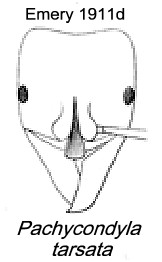 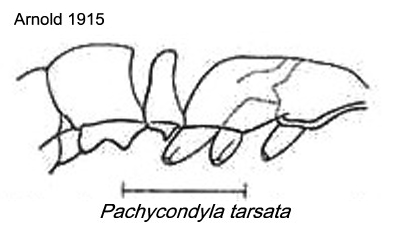 Latreille's
(1802c) description is at Latreille's
(1802c) description is at  . Lepeletier de
Saint-Fargeau (1835: 194) gave a fuller description, this is at . Lepeletier de
Saint-Fargeau (1835: 194) gave a fuller description, this is at  . F Smith (1858b) gave a
description, this is at . F Smith (1858b) gave a
description, this is at  . F Smith's (1858b) description of simillima
is at . F Smith's (1858b) description of simillima
is at  . Mayr's (1866b)
description of the male is at . Mayr's (1866b)
description of the male is at  . Emery's (1899e) description of delagoensis
is at . Emery's (1899e) description of delagoensis
is at  . Arnold (1915: 44) gave
a description, with delagoensis, these are at . Arnold (1915: 44) gave
a description, with delagoensis, these are at  . Santschi (1919h) listed and described
several varieties - these are at . Santschi (1919h) listed and described
several varieties - these are at  and his notes with a key
to the varieties is at and his notes with a key
to the varieties is at  . Santschi's (1930a)
description of striatus is at . Santschi's (1930a)
description of striatus is at  . .
|
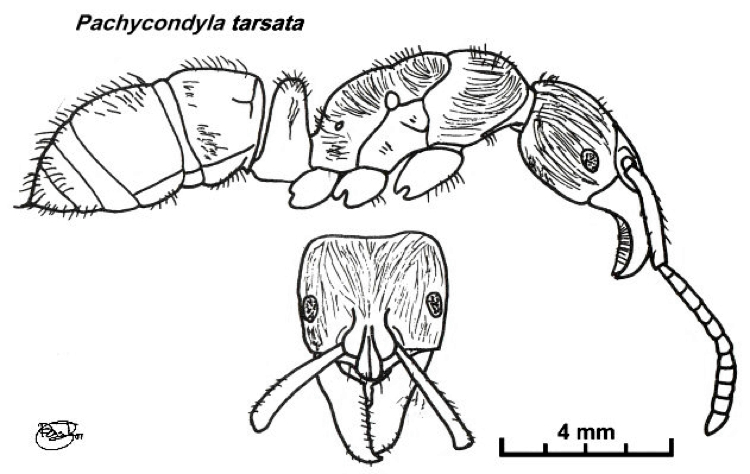 Nigeria
specimens (as Paltothyreus tarsatus, Taylor, 1976: 27). WORKER.
Monomorphic; TL 18.13 mm, HL 3.75, HW 3.67, SL 3.17, PW 2.66. Nigeria
specimens (as Paltothyreus tarsatus, Taylor, 1976: 27). WORKER.
Monomorphic; TL 18.13 mm, HL 3.75, HW 3.67, SL 3.17, PW 2.66.
Colour black, extremities dark red-brown, dull except on terminal
segments of the gaster. Relatively coarse striate sculpture on head and
alitrunk. Scattered coarse hairs all over and moderate pilosity on the
alitrunk. Clypeus with the median portion raised and projecting
forwards as a truncated lobe. Mandibles very large and elongated
triangular. Claws with a median tooth.
Commonly known as the 'Stink Ant', it nests directly
into the ground, with the entrance often surrounded by excavated soil
and remains of arthropods and other food. Usually forage singly.
Among an enormous list of records, Wheeler (1922) had it
from Senegal (Dakar, C. Alluaud; Thiès, F. Silvestri;
Casamance, Clavaux), Guinea-Bissau (Bissis Island, Lucas), Guinea
(Los Islands, C. Alluaud; Conakry, Kakoulima and
Kindia, F. Silvestri), Sierra Leone (Samlia Falls, Mocquerys), Ivory
Coast (Dimbroko, Le Moult; Jacqueville and Grand Bassam, Lohier;
Assinie, C. Alluaud), Ghana (Accra), Togo (Bismarckburg,
Conradt, Büttner) and Cameroun (Sjöstedt; F. Silvestri;
Mundame, Conradt; Bibundi, Tessmann). He also had mediana from Cameroun
(Molundu, Reichensperger).
|
From Nigeria, Lamborn (1915) described how it
(as Paltothyreus
tarsatus) played a useful role in cocoa by attacking and carrying
off termites "on every possible occasion".
Bernard (1952) had many records from the Mt. Nimba, Guinea,
collections (N'Zo, 480 m, 5 queens, 9 males; Guéguépo, 6 workers, 4
queens, 1 male; Kéoulenta, 530 m, 8 workers, 2 males; Yalanzou, 5
workers, 3 males; Sérengbara, 590 m, 1 worker; Nion, 610 m, 20 workers,
1 queen, 1 male; Thio, 680 m, 2 workers; Camp IV, 1000 m, 10 workers, 2
queens. Lamotte had remarked how it was not found above 1000 m, whereas
in southern and eastern Africa it was known from up to 2000 m;
doubtless because there the savanna and secondary forest went to such
heights.
Described (as Paltothyreus tarsatus) as
widespread in the Ghana semi-deciduous forest zone, 25
specimens from 7 sites, from leaf litter sampling, by Belshaw &
Bolton (1994b); earlier a single worker was collected from cocoa by pkd
at Kade by Majer (1975, 1976b) and 9 workers were collected from the
ground at CRIG by Bigger (1981a).
Lévieux & Diomande (1978) in their description of
the activity of Pachycondyla sennaarensis, mention this species
as found at Ferkéssédougou in the Ivory Coast Sudan savannah
zone. Lévieux (1976a) gave the nest size as 200-1000; Hölldobler (1984)
reported extensive studies of communication, foraging on termites,
tandem running and nest relocation, also internal anatomy and exocrine
glands. Braun et al. (1994) describe studies of nesting in the
Ivory Coast.
Dejean (1988), Dejean et al. (1993a, as Paltothyreus
tarsatus) studied the spatial components of its foraging activities
in Zaïre.
|
Oxford University Museum
specimens
|
 The photomontage is of a worker collected in Cameroun
- south-western tropical coastal forest area between Edéa and Campo
(McKey Wolbachia project, Cameroon 15) from location BP
(Bipaga - village at 3°07.35' N 10°00.67'; flat land north of the
forest road), 24 March 2001; on soil surface attracted to sardine oil
bait. The photomontage is of a worker collected in Cameroun
- south-western tropical coastal forest area between Edéa and Campo
(McKey Wolbachia project, Cameroon 15) from location BP
(Bipaga - village at 3°07.35' N 10°00.67'; flat land north of the
forest road), 24 March 2001; on soil surface attracted to sardine oil
bait.
|
 The
photomontage is of a queen from Ghana, collector S Sky
Stephens (06G0001). The
photomontage is of a queen from Ghana, collector S Sky
Stephens (06G0001).
|
 The
photomontage is of a worker from Gabon, Pongara National
Park; collector
Yves Braet (Gabon 52). The
photomontage is of a worker from Gabon, Pongara National
Park; collector
Yves Braet (Gabon 52).
|
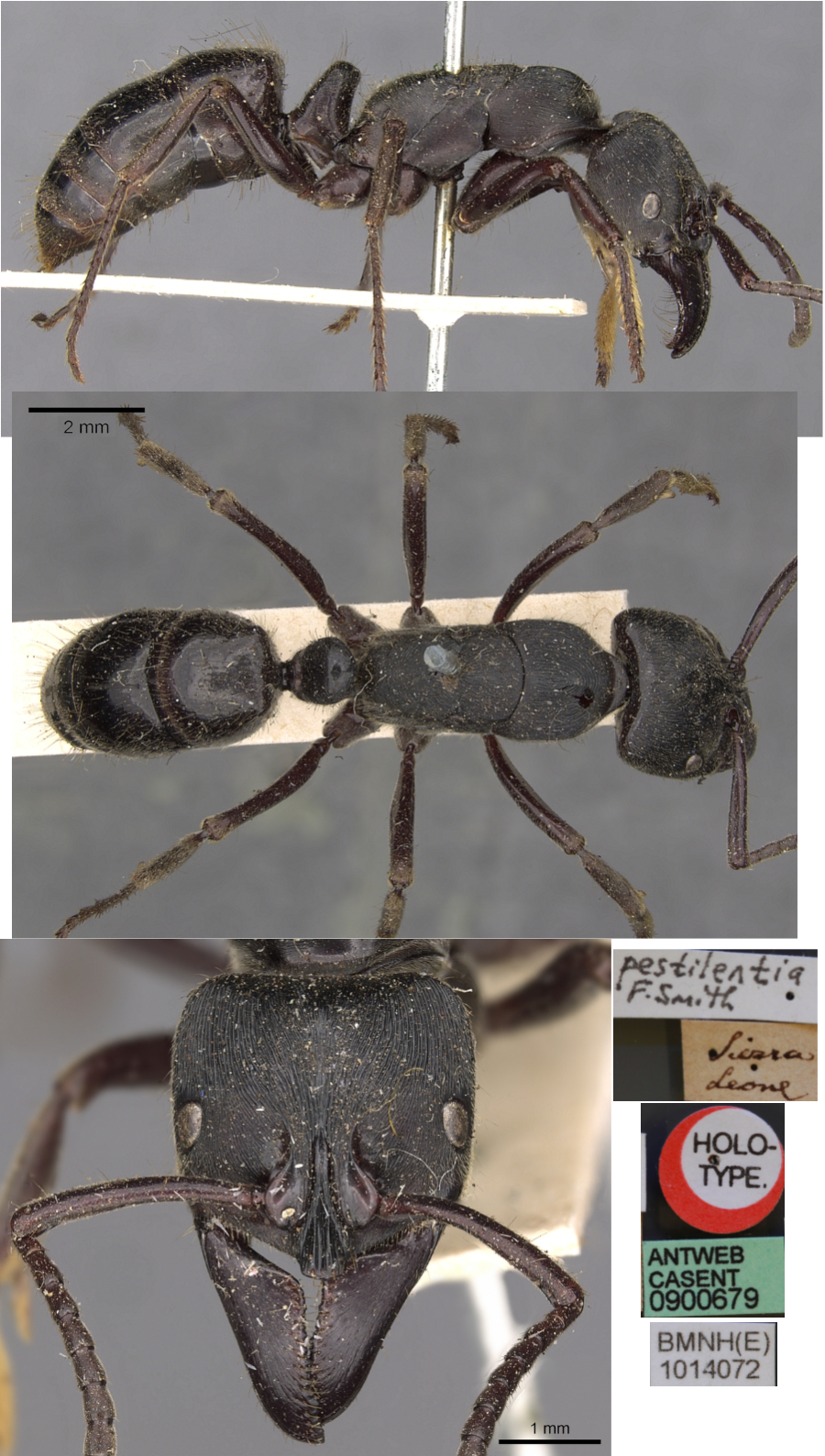 The
photomontage of the pestilentia holotype is collated from http://www.antweb.org/specimen.do?name=casent0900679. The
photomontage of the pestilentia holotype is collated from http://www.antweb.org/specimen.do?name=casent0900679.
|
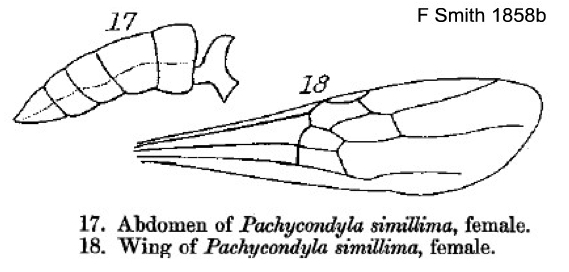 Queen Queen
|
 The photomontage is
of an alate queen from the Central
African Republic, Dzanga-Sangha NP; collector Philippe
Annoyer (CAR JA). The photomontage is
of an alate queen from the Central
African Republic, Dzanga-Sangha NP; collector Philippe
Annoyer (CAR JA).
|
 The photomontage is
of a queen from Ghana; collector S
Sky Stephens (06G0004). The photomontage is
of a queen from Ghana; collector S
Sky Stephens (06G0004).
|
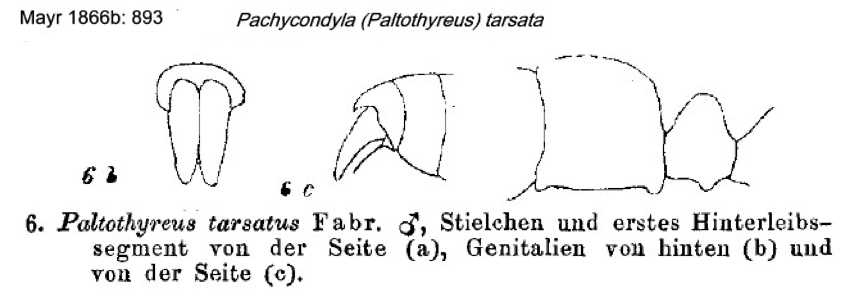 Male Male
|
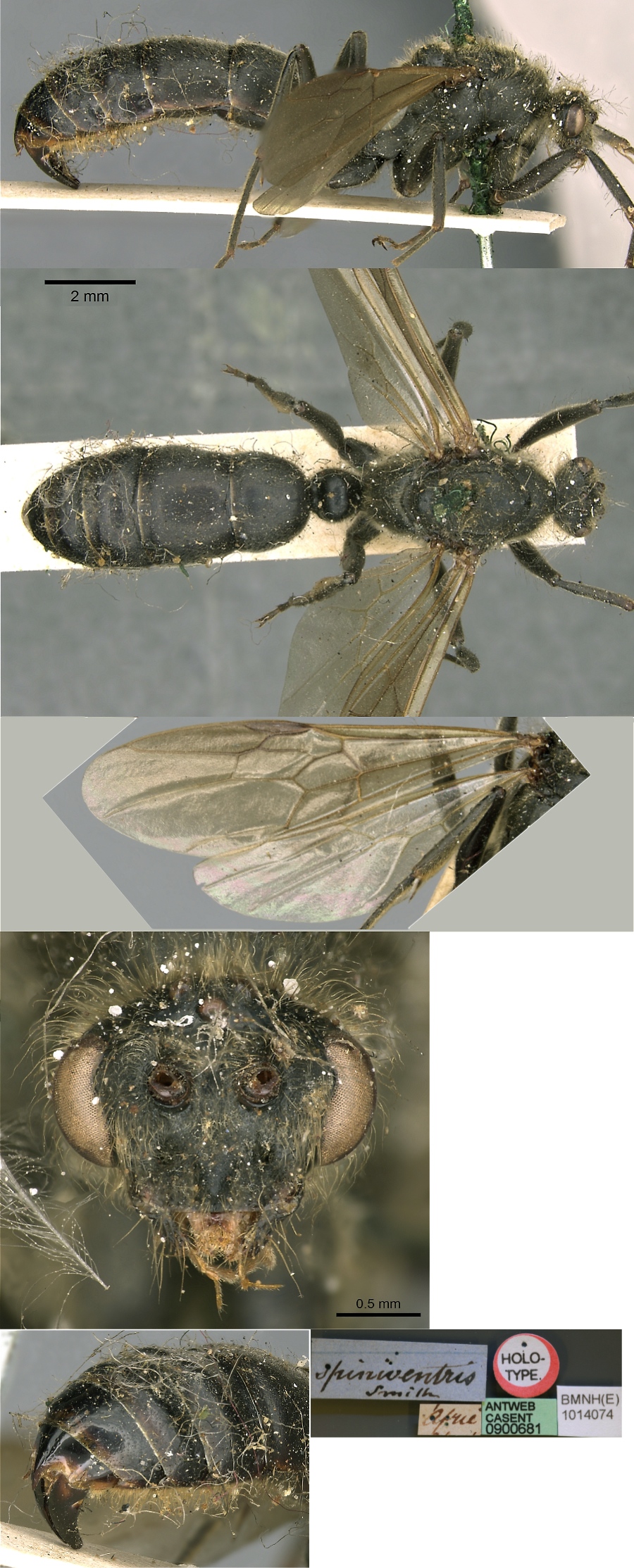 The
photomontage of the spiniventris type male is collated from http://www.antweb.org/specimen.do?name=casent0900681. The
photomontage of the spiniventris type male is collated from http://www.antweb.org/specimen.do?name=casent0900681.
|
 The
photomontage is of a male from Tai National
Park; collector Erena Dupont, iii.2014. The
photomontage is of a male from Tai National
Park; collector Erena Dupont, iii.2014.
|
 The
photomontage is of an associated worker from Tai National
Park; collector Erena Dupont, iii.2014. The
photomontage is of an associated worker from Tai National
Park; collector Erena Dupont, iii.2014.
|
|